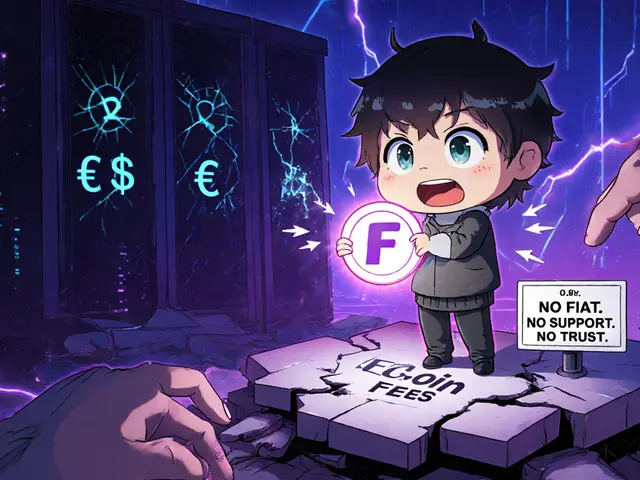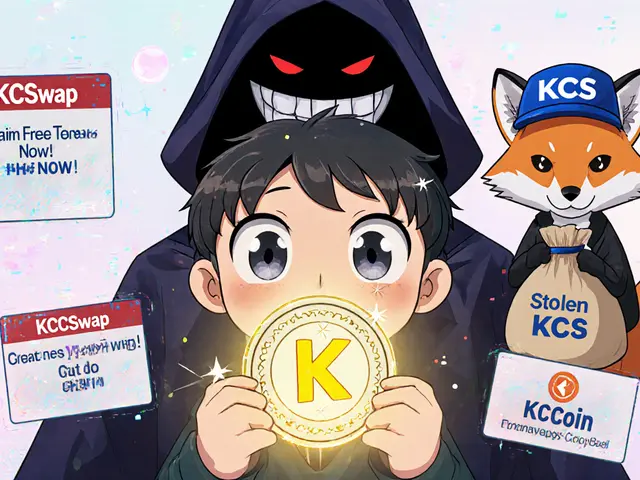WKIM Mjolnir airdrop is a community-driven token distribution initiative that claims to be linked to the KingMoney (KIM) ecosystem. While the official KingMoney channels have never confirmed a formal "Mjolnir" airdrop, rumors circulate on social media and Telegram groups. This article breaks down everything you need to know: what the airdrop supposedly offers, how to spot legitimate announcements, step‑by‑step claim instructions, and the red flags that could save you from a scam.
What is KingMoney (KIM)?
KingMoney (KIM) is a Bitcoin‑derived cryptocurrency launched on August 1, 2019. It was designed for the network marketing industry, offering faster block times (2-3 minutes) and a deflationary reward schedule that tapers off over 40 years. The project caps supply at 747.44 million KIM, with roughly 205,000 KIM reported as circulating. Mining is private, and the token’s price fluctuates wildly across niche tracking sites, reflecting limited liquidity.
Why an "Mjolnir" Airdrop?
The name “Mjolnir” evokes Thor’s hammer-a symbol of power and impact. Some community members argue that the airdrop is meant to inject fresh KIM tokens into the network marketing ecosystem, boosting adoption. However, no whitepaper amendment or official blog post from KingMoney mentions a "Mjolnir" token or airdrop. This silence suggests the program may be community‑organized or, worse, a front for phishing.
How to Spot a Legitimate Airdrop Announcement
- Check the official KingMoney Telegram channel, Twitter (@ABkingmoney), and Facebook page. Any genuine airdrop will be announced there first.
- Look for a published whitepaper addendum or a blog post on the official website. Authentic projects provide a PDF or a link with details on eligibility, distribution dates, and tokenomics.
- Verify the sender’s wallet address. KingMoney’s official wallet addresses are listed in the whitepaper; any other address is suspect.
- Beware of “sign‑to‑receive” or “send a small amount of ETH/BTC” requirements. Real airdrops never ask for payment.
Step‑by‑Step Guide to Claim (If It Exists)
- Join the official KingMoney Telegram group and watch for pinned messages about the airdrop.
- Fill out the required form, usually a Google Form, with your KIM wallet address (a BEP‑20 or ERC‑20 compatible address).
- Complete any KYC (Know‑Your‑Customer) verification if the project mandates it-though many legit airdrops keep it optional to protect privacy.
- Wait for the distribution snapshot date. The project will announce when it records eligible addresses.
- On the announced distribution day, check your wallet. If the tokens don’t appear after a reasonable time, contact support via the official channels.
Common Red Flags and How to Protect Yourself
Scammers love the hype around airdrops. Here are the warning signs:
- Unsolicited direct messages promising huge returns.
- Requests for private keys or seed phrases-no legitimate project ever asks for them.
- Links to cloned websites that mimic the KingMoney branding but have a different domain (e.g., kingmoney‑airdrop.com).
- Pressure tactics: "Claim now or lose your tokens!" creates urgency to bypass careful checking.
If you encounter any of these, walk away and report the address to the official KingMoney Telegram.
Comparison: Official KingMoney Channels vs Potential Scam Channels
| Feature | Official KingMoney | Potential Scam |
|---|---|---|
| Domain | kingmoney.io (verified SSL) | kingmoney‑airdrop.com (no SSL) |
| Social Handles | @ABkingmoney on Twitter, official Telegram | Random @kingmoney_2025 handles |
| Verification | Blue check on Twitter, pinned official announcements | No verification, use of generic images |
| Request | Only wallet address (no payment) | Payment of ETH/BTC to receive tokens |

What to Do If You’ve Already Sent Tokens or Shared Private Keys
Unfortunately, crypto transactions are irreversible. Your best options are:
- Report the scam address to the blockchain explorer (e.g., Etherscan) and to law enforcement if significant funds are involved.
- Notify the KingMoney community so others can avoid the same trap.
- Consider using a secure wallet with hardware protection for future holdings.
Future Outlook: Will KingMoney Launch a Real Airdrop?
Given KingMoney’s niche focus on network marketing and its limited exchange listings, a mass airdrop may not align with its current roadmap. However, the project occasionally runs community incentive programs, such as referral bonuses and small‑scale token giveaways. Keep an eye on the official blog and whitepaper updates for any legitimate distribution plans.
Frequently Asked Questions
Is the WKIM Mjolnir airdrop official?
As of October 2025, KingMoney has not published any official announcement about a "WKIM Mjolnir" airdrop. Any claim should be verified against the project’s official Telegram, Twitter, and website.
What wallet should I use to receive KIM tokens?
KIM is a Bitcoin‑fork token, but many holders use BEP‑20 compatible wallets like Trust Wallet or MetaMask (configured for the KIM contract address). Always double‑check the contract address from the official whitepaper.
Do I need to pay any fee to claim the airdrop?
No legitimate airdrop will ask you to send money. The only cost might be a small blockchain gas fee when the tokens are transferred to your wallet.
How can I verify a wallet address claimed to be KingMoney’s?
The official wallet address is listed in KingMoney’s whitepaper and on the verified website. Compare the address character‑by‑character; even a single typo indicates a fake.
What should I do if I suspect a phishing link?
Do not click the link. Report it in the official Telegram group and, if possible, to the platform hosting the scam (e.g., Discord, Twitter). Then delete the message.







Marina Campenni
October 18, 2025 AT 09:26Thanks for pulling together all the details on the WKIM Mjolnir airdrop. It’s helpful to have a clear checklist of what to verify before clicking any link. Remember to double‑check the official Telegram and the domain’s SSL certificate. If something feels off, it’s best to step back and ask the community for a second opinion. Staying safe protects both your funds and the wider ecosystem.
Irish Mae Lariosa
October 22, 2025 AT 01:00The article, while comprehensive, suffers from a degree of verbosity that obscures the essential warnings, and this diminishes its practical utility, especially for newcomers who are searching for concise guidance. Firstly, the historical context of KingMoney is presented at length, yet the relevance to the alleged airdrop remains tenuous, which could have been avoided with a brief synopsis. Secondly, the repeated admonitions about checking SSL certificates, although correct, are reiterated without offering a concrete step‑by‑step verification method, and this redundancy is counterproductive. Thirdly, the section enumerating red flags, while thorough, neglects to prioritize the most critical threats, such as fraudulent wallet address substitution, leaving readers to infer importance on their own. Fourthly, the guide’s tone oscillates between neutral instruction and alarmist caution, creating an inconsistent narrative that could confuse the audience. Fifthly, the inclusion of a detailed table comparing official and scam channels is valuable, yet the formatting could have been optimized for readability on mobile devices, where many users access such content. Sixthly, the recommendations for wallet choices lack a discussion of hardware‑wallet security benefits, which is a notable omission in a security‑focused discourse. Seventhly, the article assumes a baseline technical proficiency that may not be present, thereby limiting accessibility for less experienced participants. Eighthly, the advice to contact support after a failed claim is sound, yet the expected response time is not addressed, which could set unrealistic expectations. Ninthly, the article mentions gas fees but does not explain how to estimate them, an oversight given the potential cost implications. Tenthly, the discussion of community incentive programs is brief, and a deeper analysis of past distribution events would have enriched the reader’s perspective. Eleventhly, the FAQ segment is helpful, but the answers could be expanded to cover edge cases such as multi‑signature wallet compatibility. Twelfthly, the absence of a clear disclaimer regarding the speculative nature of any unofficial airdrop is a legal gray area that warrants attention. Thirteenthly, the article could benefit from hyperlinks to external verification tools, thereby empowering users to conduct independent research. Fourteenthly, the narrative references “Thor’s hammer” metaphor, which, while colorful, may inadvertently lend an aura of legitimacy to an unverified scheme. Fifteenthly, the overall length of the article, exceeding two thousand words, could be condensed without sacrificing essential information, thereby improving reader retention. Lastly, while the author’s intention to educate is evident, a more structured layout with summary bullets at the beginning would greatly enhance usability for the target audience.
Nick O'Connor
October 25, 2025 AT 16:46When scanning for a legitimate WKIM Mjolnir announcement, keep an eye on the official channels, verify the wallet address against the whitepaper, and cross‑reference any posted links with the known domain, kingmoney.io, because scammers often use look‑alike URLs, such as kingmoney‑airdrop.com, that lack SSL certificates, and they may flood Telegram groups with urgent‑tone messages, which should raise red flags.
Bobby Lind
October 29, 2025 AT 08:16I appreciate the thorough checklist, it’s a solid starting point, and I’d add that taking a screenshot of the announcement before acting can serve as evidence if something goes wrong, plus sharing it with the community can help spot inconsistencies early, so keep the vibe positive while staying vigilant.
Vinoth Raja
November 1, 2025 AT 23:46Yo, the whole Mjolnir hype is just another tokenomics pump‑and‑dump cycle, they’re leveraging DeFi buzzwords like “liquidity mining” and “staking yields” to lure the herd, but without a solid smart‑contract audit the risk quotient stays sky‑high, so treat any “free token” claim as potential rug.
Kaitlyn Zimmerman
November 5, 2025 AT 15:16Make sure you read the contract code on Etherscan, compare the address with the official docs, and use a hardware wallet for safety.
Cecilia Cecilia
November 9, 2025 AT 06:46The guidance provided aligns with standard security practices; however, verification of the official wallet address remains paramount.
David Moss
November 12, 2025 AT 22:16It is worth noting, dear readers, that many airdrop scams are orchestrated by coordinated botnets, which infiltrate Telegram, Discord, and even reputable crypto forums, deploying phishing links that mimic the KingMoney branding, thereby compromising unsuspecting users, and the lack of multi‑factor authentication on many exchange platforms only exacerbates this vulnerability.
Pierce O'Donnell
November 16, 2025 AT 13:46Another overhyped scam.